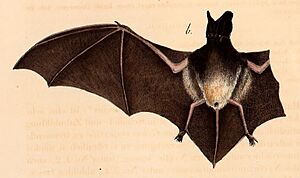Arabian barbastelle facts for kids
Quick facts for kids Arabian barbastelle |
|
|---|---|
 |
|
| Conservation status | |
| Scientific classification | |
| Genus: |
Barbastella
|
| Species: |
leucomelas
|
| Synonyms | |
|
|
The Arabian barbastelle (Barbastella leucomelas), also known as the levant barbastelle, is a type of vesper bat. These bats like to live in temperate forests and caves. They are sometimes in danger because they are losing their natural homes, which is called habitat loss. You can find the Arabian barbastelle in Egypt (especially in the Sinai area), Israel, and Eritrea.
Contents
About the Arabian Barbastelle's Name
This bat was first described as a new species in 1826 by a German scientist named Philipp Jakob Cretzschmar. He gave it the scientific name Vespertilio leucomelas at first.
The name "leucomelas" comes from Ancient Greek. It means "black and white." This name probably describes the bat's fur color.
For a long time, scientists thought this bat lived in many parts of Asia. Because of this, it was sometimes called the "eastern barbastelle" or "Asian barbastelle." However, newer studies looking at the bats' DNA showed that there were actually several different species. Scientists then realized that the Arabian barbastelle found in Egypt was a unique species. Other similar bats from Asia, like the eastern barbastelle (B. darjelingensis) and the Caspian barbastelle (B. caspica), were then recognized as their own separate species. The Japanese barbastelle (B. pacifica) was also identified as a distinct species in 2019.
Where the Arabian Barbastelle Lives
After scientists learned more about these bats, they found that the Arabian barbastelle lives in only a few places. These places are in North and East Africa and a region called the Levant, on both sides of the Red Sea. You can find them in northern Eritrea, the very southern part of Israel, and the Sinai Peninsula in Egypt. They have been seen living at high places, up to about 2,500 meters (8,200 feet) above sea level.
What the Arabian Barbastelle Looks Like
The Arabian barbastelle is a small bat. Its forearm, which is part of its wing, is about 38 to 39 millimeters (1.5 inches) long. Its tail is shorter, about 19 to 20 millimeters (0.75 inches) long.
This bat has large ears that point forward. The small, fleshy part inside its ear, called the tragus, is also quite large and very hairy. Its fur is dark, almost black, on its back. But on its belly, the fur is a lighter brown color. Its thumb is very small, only about 4 millimeters (0.16 inches) long, including the claw.
Daily Life of the Arabian Barbastelle
During the day, the Arabian barbastelle likes to rest and sleep in safe, sheltered places. These can include old buildings or caves.
Conservation Status
The Arabian barbastelle is currently listed as a species of "Least Concern" by the IUCN Red List. This means it is not considered to be in immediate danger of extinction. However, it's important to know that this status includes other species that scientists now believe are separate, like darjelingensis, caspica, and pacifica.
Because of this, we don't fully know how many Arabian barbastelles there are in North Africa, or if their numbers are growing or shrinking. Sometimes, activities related to conflict or war can be a threat to these bats. Such events can damage their homes and disturb the caves and old buildings where they like to roost.


